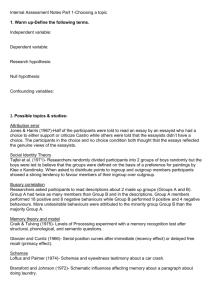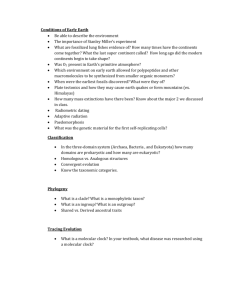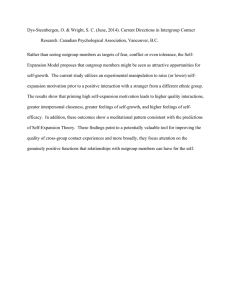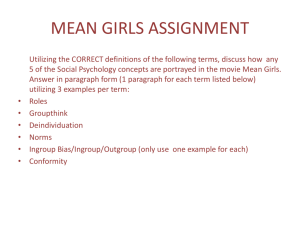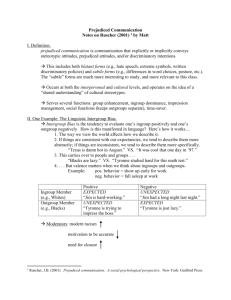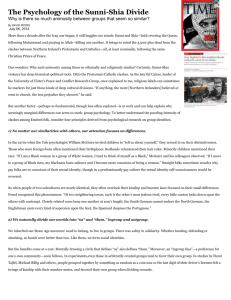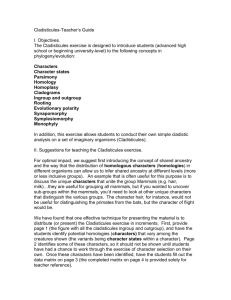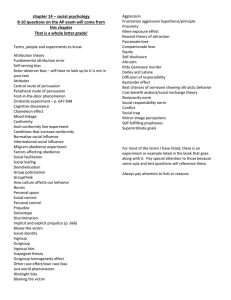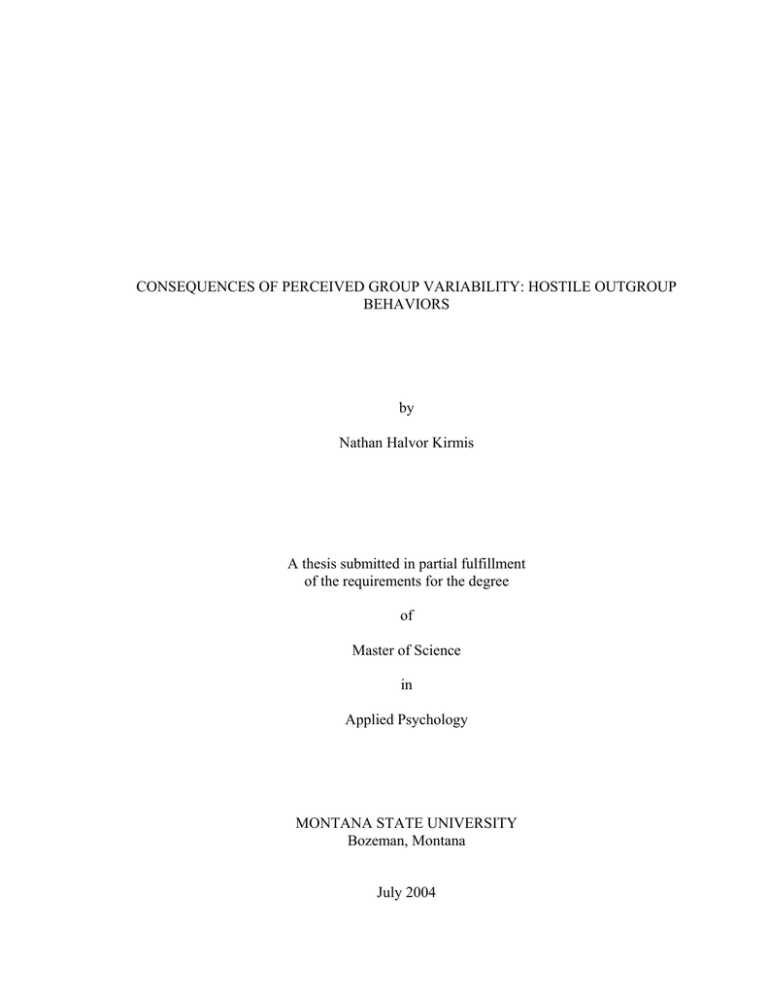
CONSEQUENCES OF PERCEIVED GROUP VARIABILITY: HOSTILE OUTGROUP
BEHAVIORS
by
Nathan Halvor Kirmis
A thesis submitted in partial fulfillment
of the requirements for the degree
of
Master of Science
in
Applied Psychology
MONTANA STATE UNIVERSITY
Bozeman, Montana
July 2004
© COPYRIGHT
by
Nathan Halvor Kirmis
2004
All Rights Reserved
ii
APPROVAL
of a thesis submitted by
Nathan Halvor Kirmis
This thesis has been read by each member of the thesis committee and has been
found to be satisfactory regarding content, English usage, format, citations, bibliographic
style, and consistency, and is ready for submission to the College of Graduate Studies.
Dr. Jennifer G. Boldry, Committee Chair
Approved for the Department of Psychology
Dr. Chuck A. Pierce, Psychology Department Head
Approved for the College of Graduate Studies
Dr. Bruce R. McLeod , Dean of College of Graduate Studies
iii
STATEMENT OF PERMISSION TO USE
In presenting this thesis in partial fulfillment of the requirements for a master’s
degree at Montana State University, I agree that the Library shall make it available to
borrowers under rules of the Library.
If I have indicated my intention to copyright this thesis by including a copyright
notice page, copying is allowable only for scholarly purposes, consistent with “fair use”
as prescribed in the U.S. Copyright Law. Requests for permission for extended quotation
from or reproduction of this thesis in whole in parts may be granted only by the copyright
holder.
Nathan Kirmis
27 May 2004
iv
TABLE OF CONTENTS
1. INTRODUCTION ..........................................................................................................1
Consequences of Group Variability................................................................................2
Cognitive Consequences....................................................................................2
Ingroup Favoring Behaviors ..............................................................................2
Theoretical Foundation: Perceived Threat......................................................................3
Present Study ..................................................................................................................3
2. METHOD .......................................................................................................................5
Participants......................................................................................................................5
Materials .........................................................................................................................5
Categorization Task ...........................................................................................5
Group Variability Manipulation ........................................................................5
Outgroup Hostility .............................................................................................7
Perceived Threat ................................................................................................7
Manipulation Checks .........................................................................................8
Procedure ........................................................................................................................9
3. RESULTS .....................................................................................................................12
Manipulation Checks ....................................................................................................13
Range Measure.................................................................................................13
Similarity Measure...........................................................................................13
Mean Measure..................................................................................................14
Intergroup Hostility.......................................................................................................15
Perceived Threat ...........................................................................................................15
4. DISCUSSION ...............................................................................................................17
5. FUTURE STUDIES......................................................................................................21
Conclusions...................................................................................................................23
REFERENCES CITED.................................................................................................25
FOOTNOTES ...............................................................................................................30
v
ABSTRACT
The present study investigated the link between perceptions of group variability
and intergroup hostility. Three-hundred and twenty undergraduates delivered noise blasts
to members of their ingroup and a competing outgroup after receiving bogus feedback
about the variability of personality scores for each group. It was hypothesized that under
conditions of outgroup homogeneity, participants would demonstrate the greatest levels
of outgroup hostility. While the average levels of outgroup hostility were greatest under
conditions of outgroup homogeneity, there were no significant differences in outgroup
hostility among the four conditions. I argue that levels of perceived threat were not
sufficiently raised to obtain a link between perceptions of group variability and
intergroup threat. Future manipulations are proposed (e.g., valence and stereotypicality),
that are likely to increase perceived threat and realize the link between outgroup
homogeneity and intergroup hostility.
1
INTRODUCTION
Research suggests individuals perceive members of their own groups (ingroup) as
more diverse than members of other groups (outgroups), an effect known as outgroup
homogeneity (Jones, Wood, & Quattrone, 1981; Judd & Park, 1988; Linville, Fischer, &
Salovey, 1989). This phenomena is witnessed in broad social categories, such as gender
and age (Park & Rothbart, 1982; Linville, 1982), as well as more exclusive groups like
sororities (Jones, Wood, & Quattrone, 1981). Most research on outgroup homogeneity
has focused on the moderators of the effect. For example, previous research has found
that outgroup homogeneity effects are strongest when the ingroup is smaller than the
outgroup (Mullen & Hu, 1989; Simon & Brown, 1987; Simon & Mummendey, 1990;
Simon & Pettigrew, 1990), in non-minimal groups than minimal groups (Mullen & Hu,
1989) and in high status groups than low status groups (Boldry & Kashy, 1999). The
research that has explored consequences of perceived group variability has concentrated
on cognitive outcomes (Lambert, 1995; Linville, 1982; Linville & Jones, 1980) and
ingroup favoring behaviors (Mummendey, Simon, Dietze, Grunert, Haeger, Kessler,
Lettgen, & Schaferhoff, 1992). The proposed research will be the first to explore the
relationship between perceptions of group variability and hostile intergroup behaviors.
2
Consequences of Perceived Group Variability
Cognitive Consequences
Research demonstrates that individuals are more likely to generalize stereotypes
of an entire group to individual members when the group is perceived as homogeneous
rather than heterogeneous (Ryan, Judd, & Park, 1996). In part, this may be because
persons who perceive group members as relatively variable are more likely to seek out
more and different information about group members and are less likely to make
judgments about ambiguous behaviors based on group stereotypes (Ryan, Bogart, &
Vendor, 2000). In addition, persons who perceive an outgroup as homogeneous, are more
likely to generalize from the behavior of an individual outgroup member to the entire
group (Nisbett, Krantz, Jepson, & Kunda, 1983). However, research demonstrates that
cognitive, affective and behavioral components of attitudes can function independently
(Mackie & Smith, 1998), leaving open the question of whether perceptions of group
variability affect behavior toward outgroup members.
Ingroup Favoring Behaviors
In general, research exploring the behavioral effects of perceived group variability
suggests that persons favor the ingroup over the outgroup both in token allocation
paradigms and in group product evaluations (e.g., Vanbeselaere, 1991). These ingroup
favoring behaviors are most evident under conditions of perceived group homogeneity
for one group and heterogeneity for the other than under conditions of equal group
3
variability. However, research has demonstrated that ingroup bias and outgroup
derogation are independent constructs (Brewer, 1979; Hinkle & Schopler, 1979). Thus,
the question remains whether perceptions of group variability affect hostile behaviors
towards outgroup members.
Theoretical Foundation: Perceived Threat
Perceptions of intergroup threat are the primary theoretical reason that perceptions
of group variability might be related to behavioral hostility. Research suggests that a
homogeneous outgroup is perceived as more threatening than a heterogeneous outgroup
(Corneille, O., Yzerbyt, V.Y., Rogier, A., & Buidin, G., 2001) perhaps because such
groups are perceived as more able to mobilize for collective action. Research has also
demonstrated that only under the pretext of threat are perceptions of group homogeneity
and negative evaluations positively correlated (Henderson-King, Henderson-King,
Zhermer, Posokhova, & Chiker, 1997). Therefore, perceptions of variability may lead to
hostile behaviors against an outgroup because more homogeneous outgroups are
perceived as threatening.
Present Study
In the following study, groups of 8 participants were told the experiment
investigated the impact of audio distractions on cognitive performance, and by
4
completing an initial task, they were categorized into one of two equal groups in
competition on a cognitive task. Perceptions of group variability were manipulated using
bogus feedback about scores of ingroup and outgroup members on a personality measure.
Intergroup hostility was measured by level of audio distraction delivered by each
participant to ingroup and outgroup members during the cognitive task.
The purpose of the present study is to define the conditions under which
perceptions of group variability lead to outgroup hostility. Because Ellemers and
colleagues (1997) demonstrated that competition is a necessary condition for differential
assignment of negative stimuli between the ingroup and outgroup, the present study
begins with a competitive context. This study is designed to explore whether perceptions
of variability on ambiguous dimensions lead to behavioral hostility against the outgroup.
5
METHOD
Participants
Three hundred and twenty introductory psychology undergraduates (160 male,
160 female) at Montana State University received partial course credit for their
participation. Five participants (3 males, 2 females) incorrectly identified to which group
they belonged and were excluded from further analyses.
Materials
Categorization Task
Participants viewed eleven slides containing a varied amount of dots, each
displayed for two seconds. Participants estimated the number of dots and were told that
the performance on this categorization task was related to cognitive ability. After
completing the task, participants were told that they and three other participants in their
session were underestimaters, whereas the remaining four participants were classified as
overestimaters. Dot slides were presented in random order to each participant.
Group Variability Manipulation
Participants completed a bogus subliminal personality measure ostensibly to
control for personality predispositions that could be possible confounds. Participants
6
viewed eight pairs of paintings and indicated which painting they preferred. After
completing the painter preference task, participants were given false feedback about the
personality scores of members of their group and the other group. Participants did not
know which scores belonged to them, and the scores were not explained except to say
that similar scores reflect similar personalities.
Participants were randomly assigned to one of four conditions. In the relative
ingroup homogeneity condition, participants received bogus feedback that members of
the ingroup scored similarly in the personality disposition measure (M= 50, SD= 3.16),
whereas members of the outgroup had varied scores (M= 50, SD= 35.59). In the relative
outgroup homogeneity condition, participants received bogus information that members
of the outgroup scored similarly on the personality disposition measure (M= 50, SD=
3.16), whereas members of the ingroup had varied scores (M= 50, SD= 35.59). In the
homogeneous equal variability condition, participants were informed that members of the
ingroup scored similarity (M= 50, SD= 3.16), as did members of the outgroup (M= 50,
SD= 3.16). In the heterogeneity equal variability condition, participants were informed
that members of the ingroup differed in scores on the personality measure (M= 50, SD=
35.59), as did members of the outgroup (M= 50, SD= 35.59). It is important to note that
the mean scores in each condition were held constant, whereas the standard deviation
between conditions was manipulated.
7
Outgroup Hostility
Behavioral hostility was measured by the level of audio distraction delivered to
members of the ingroup and outgroup. Participants were asked to select an audio
distraction on a continuum from 1 (the lowest sound perceptible by the human ear) to 110
(the loudest sound we can deliver without causing permanent ear damage) to be
delivered to both ingroup and the outgroup members. Participants were asked to select
the level of audio distraction to be delivered to the ingroup and outgroup in random order.
Each participant selected the levels of noise blasts to both the ingroup and outgroup over
three trials, which were averaged to create the ingroup and outgroup hostility index. The
ingroup index’s α = .23, and the outgroup index’s α = .28.
Perceived Threat
Participants completed several questions, constructed by the author, designed to
tap the degree of outgroup threat perceived by each participant. Participants answered
four questions on 7-point scales anchored by 1 (not at all) and 7 (very much), determining
the extent to which they felt that: (1) The outgroup is a threat to the ingroup (2) The
outgroup may have scored better than the ingroup on the cognitive task (3) The ingroup’s
chance to be entered in the lottery was threatened by the outgroup (4) The outgroup may
have diminished the ingroup’s chance of winning the lottery. Items were presented in
random order and were averaged to create a composite threat score (α = .82).
8
Manipulation Checks
To make certain that participants understood the group variability manipulation as
intended, participants completed a series of measures of perceived group variability.
Park and Judd (1990) suggested that perceived group variability is a multidimensional
construct composed of two factors: Dispersion and stereotyping. Dispersion reflects the
degree to which persons perceive group members as deviating from the group mean,
whereas stereotypicality reflects the extent to which the group as a whole is perceived as
matching the group stereotype. Because the goal of the present study was to manipulate
the perceived dispersion of the group, I employed the range measure as the primary
manipulation check. Participants completed a range rating of the ingroup and the
outgroup, which required participants to indicate on 7-point scales, anchored by 1 (very
low) and 7 (very high), where the group member who scored highest on the personality
measure belonged and where the group member that scored lowest on the personality
measure belonged.
The similarity measure required participants to indicate on a 7-point scale,
anchored by 1 (not at all) and 7 (very much), the degree to which ingroup and the
outgroup members were similar to one another and different from one another. Park and
Judd (1990) found that similarity related more strongly to dispersion than
stereotypicality, therefore the present study includes similarity as an additional
manipulation check. Stereotypicality cannot be measured in the present context because
there were no preexisting stereotypes of these laboratory created groups.
9
To ensure that participants perceived the average of the scores accurately,
participants indicated, on a 7-point scale, anchored by 1 (low) and 7 (high), where they
believed group members fell on average on the personality feedback. Each participant
rated the ingroup and the outgroup in random order.
Finally, participants completed a group categorization manipulation check, where
they were asked to indicate to which group they belonged. Participants that provided an
incorrect answer were excluded from further analysis, because it was crucial that
participants understood to which group they belonged.
Procedure
Participants were recruited in same-sex groups of eight and seated in separate
cubicles. All measures were completed on personal computers. Upon entering the
laboratory, participants were told that they will be engaging in a study investigating the
impact of audio distractions on cognitive performance. In order to bolster the cover
story, the participants were told that they would be categorized into two groups based on
their tendency to overestimate or underestimate, and that the two groups were to compete
against one another on a cognitive task. Participants were told that they were to complete
a cognitive task, the “lost on the moon problem,” while receiving audio distractions
delivered through headphones. The “lost on the moon problem” provides participants
with fifteen items, which they must rank on a scale of importance for survival, if a group
were to be stranded on the moon and must make a 200-mile journey across the moon to
10
meet the mother ship. Participants were told that their responses would be graded as a
group, according to criteria provided by NASA. Participants were instructed that the
group with the highest score on the task would be entered into a lottery for $100 (to be
split evenly among the four group members). After putting on headphones connected to
their computers, participants completed the group categorization task and were told that
they and three other members in the session were members of the underestimater group,
whereas the four other participants were members of the overestimater group.
Participants were then asked to complete the painter preference task, explained as
a subliminal personality measure, in order to control for personality predispositions that
could be possible confounds. Upon completion of the task, participants received bogus
feedback about the scores of their group (underestimaters) and the other group
(overestimaters), as described in the group variability manipulation section.
Participants were then told that one member of their group must be selected to
deliver the audio distraction to members of the ingroup (underestimaters) and outgroup
(overestimaters). Each participant randomly chose a number between 1 and 100 and
were instructed that whoever was closest to the random number generated by the
computer was selected to deliver the audio distraction. Although each participant was
told that they were the sole person selected, all participants were instructed that they were
chosen to deliver the audio distraction, ranging from 1 (the lowest sound perceptible by
the human ear) to 110 (the loudest sound we can deliver without causing permanent ear
damage). In order to eliminate self interest as a potential explanation for differential
noise allocation to the ingroup and outgroup, participants were told that because they
11
were selected to deliver the audio distraction, they were not entered into the lottery.
Participants were instructed to choose values to deliver noise blasts to the ingroup and the
outgroup over three trials. Participants were informed that the noise distractions were
delivered once the two groups began the lost on the moon task. At this point, each
participant were instructed to wait until the whole group had completed this portion of the
experiment.
In order to legitimize the cover story, each participant was told that they would
hear a audio distraction, so that other members of the group could not identify the
individual responsible for delivering the audio distraction. Over the headphones, all
participants heard a classical music interlude for approximately five minutes.
Participants were told that they were allowed to play Solitaire while the other members of
the two groups completed the cognitive task. After five minutes, participants completed
the perceived threat and manipulation checks. Participants were thanked for their
participation, debriefed, and excused.
12
RESULTS
First, it was important to ensure that participants perceived group variability as
intended. The accuracy of the participants’ perceptions were verified through three sets
of manipulation checks: The range, similarity, and mean measure. Each set of
manipulation checks were analyzed using a 4 (condition: Relative ingroup homogeneity,
relative outgroup homogeneity, relative homogeneity equal, or relative heterogeneity
equal) X 2 (target group: Ingroup or outgroup) mixed model ANOVA with repeated
measures on the last factor1. It was predicted that for each manipulation check, there
would be no significant difference between ratings of the ingroup versus the outgroup in
the equal homogeneity and equal heterogeneity conditions. However, it was expected
that participants in the ingroup homogeneity condition would indicate a greater range
among members of the outgroup than the ingroup and greater similarity among members
of the ingroup than the outgroup. Conversely, it was expected that participants in the
outgroup homogeneity condition would indicate a greater range among members of the
ingroup than the outgroup and greater similarity among members of the outgroup than the
ingroup
13
Manipulation Checks
Range Measure
Analyses produced the predicted condition x group interaction, F(3,308)= 52.13,
p<.01. Simple main effects tests exploring ingroup vs. outgroup perceptions for each
condition separately revealed a group effect for the ingroup homogeneity condition,
F(1,72)= 36.31, p<.01 and the outgroup homogeneity condition, F(1,84)= 51.88, p<.01.
In the ingroup homogeneity condition, participants indicated a greater range among
members of the outgroup (M= 4.33, SD= 1.63) than the ingroup (M= 2.90, SD= 1.16),
and in the outgroup homogeneity condition, participants indicated a greater range among
members of the ingroup (M= 5.26, SD= 1.73) than the outgroup (M= 3.39, SD= 1.68). As
intended, there were no group effects in either the equal homogeneity, F(1,76)= .15, ns or
equal heterogeneity conditions, F(1,76)= .07, ns.
Similarity Measure
Because Park & Judd (1990) found dispersion and similarity were related, a
similarity manipulation check was also included. Analyses produced the predicted
condition x group interaction, F(3,312)= 105.53, p<.01. Simple main effects tests,
exploring ingroup vs. outgroup perceptions for each condition separately, revealed a
group effect for the ingroup homogeneity condition, F(1,75)= 84.81, p<.01 and the
outgroup homogeneity condition, F(1,85)= 119.76, p<.01. In the ingroup homogeneity
condition, participants indicated greater similarity among members of the ingroup (M=
14
4.91, SD= 1.61) than the outgroup (M= 2.59, SD= 1.29), and in the outgroup
homogeneity condition, participants indicated greater similarity among members of the
outgroup (M= 5.29, SD= 1.64) than the ingroup (M= 2.72, SD= 1.41). As intended, there
were no group effects in either the equal homogeneity condition, F(1,76)= 0.54, ns, or in
the equal heterogeneity condition, F(1,76)= 0.00, ns.
Mean Measure
The mean measure was included to ensure that participants perceived the mean
scores accurately. Recall that the actual means were held constant across all conditions.
However, analyses produced a condition x group interaction, F(3,312)= 4.11, p<.01.
Simple main effects tests exploring ingroup vs. outgroup perceptions for each condition
separately revealed a group effect for the ingroup homogeneity condition, F(1,75)= 4.52,
p<.05 and the outgroup homogeneity condition, F(1,85)= 2.91, p<.10. In the ingroup
homogeneity condition, participants indicated a greater mean for the outgroup (M= 5.38,
SD= 1.20) than the ingroup (M= 5.09, SD= .88). In the outgroup homogeneity condition,
participants suggested a greater mean among the ingroup (M= 5.30, SD= 1.13) than the
outgroup (M= 5.08, SD= .79). In the equal heterogeneity condition, analyses indicated an
unexpected group effect, F(1,76)= 5.19, p<.05. The mean was greater for the ingroup
(M= 5.62, SD= 1.20) than the outgroup (M= 5.42, SD= 1.08). As intended, there was no
group difference in the equal homogeneity condition, F(1,76)= 1.53, ns.
15
Intergroup Hostility
The data were analyzed using a 2 (sex: Male or female) X 4 (condition: Relative
ingroup homogeneity, relative outgroup homogeneity, relative homogeneity equal, or
relative heterogeneity equal) X 2 (target group: Ingroup or outgroup) mixed model
ANOVA with repeated measures on the last factor.2 It was expected that participants
would deliver the highest audio blasts when the outgroup was perceived as homogeneous
relative to the ingroup, yielding a significant group x condition interaction. Results failed
to find the predicted interaction. There was only a significant sex effect, such that males
(M= 55.23, SD= 21.08) delivered higher noise blasts than females (M= 49.03, SD=
20.58), F(1,308)= 10.73, p<.01.
Perceived Threat
The data were analyzed using a one-way between subjects ANOVA (condition:
Relative ingroup homogeneity, relative outgroup homogeneity, relative homogeneity
equal, or relative heterogeneity equal)3. There was no evidence of the predicted
condition effect on threat, indicating that perceptions of threat were equivalent across
groups. The means in the ingroup homogeneity condition (M= 3.01, SD= 1.53), outgroup
homogeneity condition (M= 3.28, SD= 1.49), equal homogeneity condition (M= 3.19,
SD= 1.31), and equal heterogeneity condition (M= 3.09, SD= 1.44), demonstrated that
threat levels did not significantly differ by condition, F(3,312)= .61, p<.61 It was
16
predicted that threat would be a mediating factor between perceived variability and
behavioral hostility. Although I predicted a mediation model, because threat did not
differ by condition, there was no reason to examine such a mediation model.
17
DISCUSSION
This study was designed to explore the behavioral effects of perceptual group
variability on ambiguous dimensions with regard to intergroup hostility. Based on
previous research on ingroup bias (Gaertner & Schopler, 1998; Vanbeseaere, 1991), it
was anticipated that participants would deliver the highest audio blasts when the outgroup
was perceived as homogeneous relative to the ingroup. That is, hostile behaviors towards
the outgroup should have been most apparent in the relative outgroup homogeneity
condition. While hostility means are in the right direction, such that behavioral outgroup
hostility was more evident in outgroup homogeneity conditions, the predicted interaction
did not emerge.
These patterns are not likely a result of ineffective manipulations. To the contrary,
perceptions of group variability were manipulated to the intended degree in this study.
Analysis of the range and similarity measures demonstrated that participants perceived
the ingroup as homogenous in the ingroup homogeneity condition and the outgroup as
homogeneous in the outgroup homogeneity condition. As intended, participants in the
equal homogeneity and equal heterogeneity conditions did not perceive any significant
differences between the ingroup and outgroup.
Several issues revealed in this study that must be addressed in future studies in
order to fully realize the potential link between perceptions of group variability and
intergroup hostility. First, the coefficient alphas for the audio distraction measure were
very low, as participants selected varied and inconsistent levels of distraction over the
18
three trials. A possible solution to this issue is to remind participants of the potential
rewards while they select each level of audio distraction. Increasing the frequency and
recency of reward cues may remind participants of the present competition, the possible
benefits of their actions, and the potential threat posed by the outgroup in achieving the
reward. The potential rewards for their actions may stay in their present, conscious
thought and therefore, increase perceived threat. Furthermore, implementing immediate
rewards for participants may increase levels of competition and threat, as opposed to
entering participants in a lottery to be won in the future. In addition, introducing a
guaranteed reward may induce further competition and threat, where participants are told
that the winner of that particular interaction will definitely receive the monetary reward,
not simply entered into a lottery. These methodological solutions should generate more
consistent audio distractions across the three trials and raise the coefficient alphas for the
measure.
Second, in addition to increasing the frequency and recency, reward cues could be
presented in a group-based context. Perceived competition may be attenuated in the
present study because participants are told they are excluded from the competition since
they are selecting the levels of audio distraction. However, identification with the
ingroup (i.e., social identity) could be primed with the reward cues, and participants
could be reminded that their actions could influence their group’s chances of winning the
competition against the outgroup. Research demonstrates that while an individual’s selfinterest in monetary rewards are directly linked to the ingroup’s absolute profit,
individuals will sacrifice personal gains and favor the ingroup in order to achieve
19
intergroup differences in reward allocation (Turner, Brown, & Tajfel, 1979).
Consequently, by priming ingroup identification and group-based reward, the coefficient
alphas for the intergroup hostility measure, perceived competition levels, and perceived
threat may be further raised. Research also suggests that in minimal group paradigms,
individuals favor the ingroup behaviorally because they follow scripts that are currently
accessible (Hertel & Kerr, 2001). Thus, a stem-completion task could be included in the
study, prior to the intergroup hostility measure, where group-based concepts (e.g. loyalty,
team) would be primed. Such a task may lead to increased ingroup identification and
favoritism implicitly, and therefore, completion of the task may motivate participants to
further assist the ingroup obtain the monetary reward, despite the lack of self-interest.
Third, the mean manipulation check yielded an unintended group x condition
interaction. Despite holding the mean constant across conditions, participants in the
outgroup homogeneity condition indicated that the ingroup scored higher on average than
the outgroup, whereas participants in the ingroup homogeneity condition indicated that
the outgroup scored higher on average than the ingroup. It may be that the extreme
positive scores provided under conditions of heterogeneity are especially salient for
participants in comparison to the moderate scores provided under conditions of
homogeneity.
Results also suggested that participants in the equal heterogeneity condition
indicated that the ingroup scored higher on average than the outgroup, whereas
participants in the equal homogeneity condition indicated that the ingroup and outgroup
scored equally. It may be that the extreme scores included in the bogus personality
20
feedback under conditions of equal heterogeneity created uncertainty among participants.
That is, participants perceived that scores differed and instead of attributing the
differences among groups to variability, made the less complicated attribution that one
group must have scored higher than the other group. Because participants were
uncertain, they employed the common assumption that the ingroup scored higher than the
outgroup.
Finally, greater manipulation of perceived threat is needed in order to fully realize
a link between perceptions of group variability and intergroup hostility. Participants did
not perceive the outgroup as more threatening under conditions of homogeneity than
under conditions of variability. If threat is indeed a mediator of the link between group
perceptions and outgroup hostility, greater threat must be induced. Several methods
could be employed to increase perceived threat. I have already discussed methodological
changes that could be induced in the study protocol to increase perceived threat such as
increasing the frequency, immediacy, and certainty of rewards as well as priming the
social identity prior to completing the noise allocation task. In addition, properties of the
personality feedback (e.g., valence, stereotypicality) might be manipulated to increase
perceived intergroup threat. These additional manipulations are discussed in the
following section.
21
FUTURE STUDIES
Future research should include perceptions of positive and negatively valenced
perceptual dimensions in the group variability manipulation. It may be that outgroup
homogeneity is a catalyst for intergroup hostility only when the perceptual dimensions
are negative. Specifically, a negatively valenced homogeneous outgroup may produce a
sufficient amount of perceived threat to lead to the predicted outgroup hostility. With
sufficient levels of threat, it is predicted that perceptions of group variability will lead to
intergroup hostility through perceived threat.
The procedure and measures for future studies would duplicate those of the
present study (with the appropriate methodological changes noted above), except that the
scores from the personality measure would either be a positively or negatively valued.
Specifically, positive scores would reflect a personality dimension that has been rated as
highly positive, whereas a negative scores would reflect a personality dimension that has
been rated as highly negative. This study would investigate whether perceptions of trait
valence is a contributing factor that drives intergroup hostility. Historical events have
shown that groups that have been targets of intergroup hostility, such as Jews during the
Holocaust, were perceived by another group as homogenous on negative traits. These
common negative traits created the perception that such a group was more dangerous, and
the homogeneity of the group created the perception that they could easily mobilize
against another group. Research suggests that groups perceived as homogeneous are seen
as more able to mobilize for collective action and therefore perceived as more threatening
22
(Corneille, O., Yzerbyt, V.Y., Rogier, A., & Buidin, G., 2001). Furthermore, research
demonstrates that individuals view negatively perceived groups as more threatening to
the self than positively perceived groups (Zarate, Garcia, Garza & Hitlan, 2004).
Therefore, negatively valenced outgroups may be perceived as more cohesive unit,
thereby posing a greater threat
In addition to the inclusion of valence as a perceptional dimension of group
variability, further manipulations may be added to increase perceptions of outgroup
threat. Stereotypical dimensions may also be included in the explanation of scores in the
group variability manipulation, where scores are explicated in terms of specific
personality traits, such as conservatism and liberalism. Research suggests a direct link
between perceived threat and negative stereotypes (Stephan & Stephan, 2000).
Consequently, by presenting stereotypicality as a dimension of group variability may
further induce perceived threat. Second, a future study could offer participants
immediate rewards to participants, where the experimenter would state that the winning
group would receive a monetary reward after each session. This may increase
participants’ incentive to further distract the outgroup and assist the ingroup. While this
manipulation may not create a difference in levels of delivered audio distraction across
conditions, it may increase the consistency of behavioral hostility responses across trials.
That is, the coefficient alpha for the intergroup hostility measure would be increased, and
it would increase participants’ interest in participation and competition. With the above
stated added manipulations, the problems of the first study would be addressed, and most
importantly, levels of perceived threat of the outgroup would be enhanced.
23
Conclusions
History suggests that outgroup hostility occurs with very negative homogenized
perceptions of outgroup members, as in such historical instances of outgroup hostility as
the Holocaust, the Israeli-Palestinian conflict, and Japanese internment camps during
World War II. Research has shown that in Israeli adolescents, stereotypic perceptions
and attitudes towards outgroups become more negative after terrorist attacks,
demonstrating that intergroup perceptions and attitudes are context-based (Bar-Tel &
Labin, 2001). Furthermore, Doojse and Branscombe (2003) displayed that ingroup
identification, exaggerated by negative behavior of group, as in the Second World War in
Germany, significantly predicts outgroup homogeneity and perceptions of differences
between groups. While such research shows that exacerbated stereotypes and negative
attitudes may be positively correlated with hostile behavior, the current research
investigates whether perceptions of group variability may lead to the hostile intergroup
behavior.
Although this and future studies were designed to investigate the effect of
perceived group variability as a cause of hostile behaviors against the outgroup, it may be
that the relationship is bidirectional. That is, perceptions of group homogeneity may also
be a result of hostility. If persons behave hostilely towards outgroup members out of
their own volition, such behavior may cause the individual to perceive the outgroup as
more homogeneous. This potential phenomenon may occur as the individual seeks
cognitive justification for behavioral hostility towards the outgroup, which would be
24
supported by Festinger’s theory of cognitive dissonance (1957). A hostile act towards an
outgroup may arouse dissonance within an individual, and thereby causing the individual
to seek validation by modifying their perceptions of the outgroup, which may strengthen
the connection between perceptions of group variability and outgroup hostility. This
possible relationship presents an avenue for future research.
The present study demonstrates the importance of perceived threat as a mediating
factor in the link between perceptions of group variability and intergroup hostility. The
design failed to stimulate the necessary amount of perceived threat among participants,
demonstrating that perceptions of group variability alone are not sufficient to induce
intergroup hostility. With increased levels of perceived threat, perceptions of a
homogeneous outgroup should generate significantly greater amounts of hostility.
25
REFERENCES CITED
Bar-Tel, D. & Labin, D. (2001). The effect of a major event on stereotyping:
Terrorist attacks in Israel and Israeli perceptions of Palestinians, Jordanians and Arabs.
European Journal of Social Psychology, 31, 265-280.
Boldry, J.G. & Kashy, D.A. (1999). Intergroup perception in naturally occurring
groups of differential status: A social relations perspective. Journal of Personality and
Social Psychology, 77, 1200-1212.
Brewer, M.B. (1979). Ingroup bias in the minimal intergroup situation: A
cognitive-motivational analysis. Psychological Bulletin, 86, 307-324.
Corneille, O., Yzerbyt, V.Y., Rogier, A., & Buidin, G. (2001). Threat and the
group attribution error: When threat elicits judgments of extremity and homogeneity.
Personality and Social Psychology Bulletin, 27, 437-446.
Doosje, B. & Branscombe, N.R. (2003). Attributions for the negative historical
actions of a group. European Journal of Social Psychology, 33, 235-248.
Ellemers N., Spears, R., & Koomen, W. (1997). Sticking together or falling
apart: Ingroup identification as a psychological determinant of group commitment versus
individual mobility. Journal of Personality and Social Psychology, 72, 617-626.
Festinger, L. (1957). A Theory of Cognitive Dissonance. Evanston, IL: Row,
Peterson.
26
Gaertner, L. & Schopler, J. (1998). Perceived group entitativity and intergroup
bias: An interconnection of self and others. European Journal of Social Psychology, 28,
963-980.
Henderson-King, E., Henderson-King, D., Zhermer, N., Posokhova, S., & Chiker,
V. (1997). Ingroup favoritism and perceived similarity: A look at Russians’ Perceptions
in the Post-Soviet era. Personality and Social Psychology Bulletin, 23, 1013-1021.
Hertel, G. & Kerr, N.L. (2001). Priming in-group favoritism: The impact of
normative scripts in the minimal group paradigm. Journal of Experimental Social
Psychology, 37, 316-324.
Hinkle, S. & Schopler, J. (1979). Ethnocentrism in the evaluation of group
products. In W.G. Austin & S. Worchel (Eds.), The Social Psychology of Intergroup
Relations (pp.33-47). Monterey, CA: Brooks/Cole Publishing Company.
Jones, E.E., Wood, G.C. & Quattrone, G.A. (1981). Perceived variability of
personal characteristics in ingroups and outgroups: The role of knowledge and
evaluation. Personality and Social Psychology Bulletin, 7, 523-528.
Judd, C.M. & Park, B. (1988). Outgroup homogeneity: Judgments of variability
at the individual and group levels. Journal of Personality and Social Psychology, 54,
778-788.
Lambert, A. (1995). Stereotypes and social judgement: The consequences of
group variability. Journal of Personality and Social Psychology, 68, 388-403.
Linville, P.W. (1982).
The complexity-extremity effect and age-based
stereotyping. Journal of Personality and Social Psychology, 42, 193-211.
27
Linville, P.W., Fischer, G.W., & Salovey, P. (1989). Perceived distributions of
the characteristics of ingroup and outgroup members. Empirical evidence and a computer
simulation. Journal of Personality and Social Psychology, 57, 165-188.
Linville, P.W., & Jones, E.E. (1980). Polarized appraisals of outgroup members.
Journal of Personality and Social Psychology, 38, 689-703.
Mackie, D.M. & Smith, E. (1998).
Intergroup relations: Insights from a
theoretically integrative approach. Psychological Review, 105, 499-529.
Mullen, B., & Hu, L. (1989). Perceptions of ingroup and outgroup variability: A
meta-analytic integration. Basic and Applied Social Psychology, 10, 233-252.
Mummendey, A., Simon, B., Dietze, C., Grunert, M., Haeger, G., Kessler, S.,
Lettgen, S., & Schaferhoff, S. (1992).
Categorization is not enough: Intergroup
discrimination in negative outcome allocation. Journal of Experimental Psychology, 28,
125-144.
Nisbett, R., Krantz, D., Jepson, C., & Kunda, Z. (1983). The use of statistical
heuristics in everyday inductive reasoning. Psychological Review, 90, 339-363.
Park, B. & Judd, C.M. (1990).
Measures and models of perceived group
variability. Journal of Personality and Social Psychology, 59, 173-191.
Park, B. & Rothbart, M. (1982). Perception of outgroup homogeneity and levels
of social categorization: Memory for the subordinate attributes of ingroup and outgroup
members. Journal of Personality and Social Psychology, 42, 1051-1068.
28
Ryan, C.S., Bogart, L.M., & Vendor, J.P. (2000). Effects of perceived group
variability on gathering information about individual group members.
Journal of
Experimental Social Psychology, 36, 90-101.
Ryan, C., Judd, C., & Park, B. (1996). Effects of racial stereotypes on judgments
of individuals: The moderating role of perceived group variability.
Journal of
Experimental Social Psychology, 32, 71-103.
Simon, B. & Brown, R.J. (1987). Perceived intragroup homogeneity in minoritymajority contexts. Journal of Personality and Social Psychology, 53, 703-711.
Simon, B. & Mummendey, A. (1990). Perceptions of relative group size and
group homogeneity: We are the majority and they are all the same. European Journal of
Social Psychology, 20, 351-356.
Simon, B., & Pettigrew, T.F. (1990).
Social identity and perceived group
homogeneity: Evidence for the ingroup homogeneity effect. European Journal of Social
Psychology, 20, 269-286.
Stephan, W.G. & Stephan C.W. (2000). An integrated threat theory of prejudice.
In Oskamp, S. (Ed.) Reducing prejudice and discrimination, (pp. 23-45). Mahway, NJ:
Lawrence Erlbaum Associates.
Turner, J.C., Brown, R.J., & Tajfel, H. (1979). Social comparison and group
interest in ingroup favouritism. European Journal of Social Psychology, 9, 187-204.
Vanbeselaere, N. (1991). The impact of ingroup and outgroup homogeneity/
heterogeneity upon intergroup relations. Basic and Applied Social Psychology, 12, 291301.
29
Zarate, M.A., Garcia, B., Garza, A.A., & Hitlan, R.T. (2004). Cultural threat and
perceived realistic group conflict as dual predictors of prejudice. Journal of
Experimental Social Psychology, 40, 99-105.
30
FOOTNOTES
1. Analyses of manipulation checks were conducted with sex as a predictor,
however results did not reveal any sex effects. Consequently, sex was not included in the
results for all three manipulation checks.
2. Participants were inconsistent in their delivery of audio blasts across the three
trials. The alphas for the intergroup hostility measure were very low, ingroup hostility α=
.23 and outgroup hostility α= .28, showing that while participants may have selected high
levels of intergroup hostility in some trials, they were not delivering a consistent level
across all three trails. Given the poor reliabilities, tests were conducted on the individual
trials. In delivering the noise blasts, there was not a significant group x condition
interaction between conditions in the first trial, F(3,308)= .74, ns, in the second trial,
F(3,308)= 1.69, ns, or in the third trial, F(3,308)= 1.43, p=.23.
3. Analysis of perceived threat was conducted with sex as a predictor, however
results did not reveal any sex effects. Consequently, sex was not included in the results
for perceived threat.

